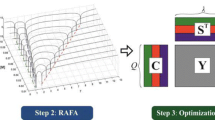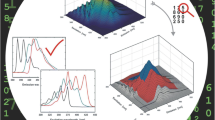Abstract
Despite of widely application of multivariate analysis in chemometrics, problem of resolving closely positioned components in the fluorescence spectra remained unsolved, thus limiting the usage of fluorescence spectroscopy in analytical purpose. In this paper we have described a novel procedure, adapted especially for the analysis of complex fluorescence spectra with multiple, closely positioned components’ maxima. The method was first tested on the simulated spectra and then applied on the spectra of proteins whose fluorophores have similar properties of both the excitation and the emission spectra. In this paper, simple but efficient modification of the method was applied. Instead of analyzing full size emission matrix (12 spectra), 9 spectra wide windows were analyzed, and 4 factors (greatest possible number of factors with physical meaning both for actin and simulated spectra) were extracted in each pass. Obtained factor scores were grouped by using the K-means algorithm. Groups of factor scores obtained from K-means algorithm were passed through the one more factor analysis (FA) in order to find one factor that represents each group. Our approach provides resolution of extremely closed spectral components, which is a vital data for protein conformation analysis based on fluorescence spectroscopy.






Similar content being viewed by others
References
Radotić K, Kalauzi A, Djikanović D, Jeremić M, Leblanc R, Cerović Z (2006) Component analysis of the fluorescence spectra of the lignin model compound-dehydrogenative polimer. J Photochem Photobiol B Biol 83:1–10
Kalauzi A, Mutavdžić D, Djikanović D, Radotić K, Jeremić M (2007) Application of asymmetric model in analysis of fluorescence spectra of biologically important molecules. J Fluoresc 17:319–329
Djikanović D, Kalauzi A, Jeremić M, Mićić M, Radotić K (2007) Deconvolution of fluorescence spectra: Contribution to the structural analysis of complex molecules. Colloids Surf B: Biointerfaces 54:188–192
Šašić S, Antić-Jovanović A, Kuzmanović M, Jeremić M (1999) Quantitative analysis of the Raman spectra of mixtures of weakly interacting components by factor analysis methods. Analyst 124:1481–1487
Tauler R, Kowalski B (1993) Multivariate curve resolution applied to spectral data from multiple runs of an industrial process. Anal Chem 65:2040–2047
Garrido M, Rius FX, Larrechi MS (2008) Multivariate curve resolution-alternating least squares (MCR-ALS) applied to spectroscopic data from monitoring chemical reactions processes. Anal Bioanal Chem 390:2059–2066
Esteves Da Silva JCG, Machado AASC (1996) Interaction of fulvic acids with Al(III) studied by self-modeling curve resolution of second-derivative synchronous fluorescence spectra. Appl Spectrosc 50:436–443
Esteves Da Silva JCG, Machado AASC (1995) Self-modelling curve resolution analysis of synchronous fluorescence spectroscopy data for characterization of acid mixtures and study of acid–base equilibria. Analyst 120:2553–2560
Esteves Da Silva JCG, Machado AASC, Oliveira CJS (1996) Study of the interaction of a soil fulvic acid with UO22+ by self-modelling mixture analysis of synchronous molecular fluorescence spectra. Analyst 121:1373–1379
Keller HR, Massart DL (1991) Peak purity control in liquid chromatography with photodiode-array detection by a fixed size moving window evolving factor analysis. Anal Chim Acta 246(2):379–390
De Juan A, Maeder M, Hancewicz T, Tauler R (2005) Local rank analysis for exploratory spectroscopic image analysis. Fixed Size Image Window-Evolving Factor Analysis. 77(1):64–74
Feuer G, Molnár F, Pettkó E, Straub FB (1948) Studies on the composition and polymerization of actin. Hung Acta Physiol 1:150–163
Spudich JA, Watt S (1971) The regulation of rabbit skeletal muscle contraction. J Biol Chem 246:4866–4871
Ladokhin AS (2000) Fluorescence spectroscopy in peptides and protein analysis. In: Meyers RA (ed) Encyclopedia of analytical chemistry. John Wiley&Sons Ltd, Chichester, pp 5762–5779
Acknowledgments
Grant 173017 from the Ministry of Education and Science of the Republic of Serbia supported this study. We thank to Mr Dragosav Mutavdžić for critical reading of this paper. This study was supported by the Hungarian Science Foundation (OTKA grant K77840 to MN) and also by the ‘Science, Please! Research Team on Innovation’ (SROP-4.2.2/08/1/2008-0011).
Author information
Authors and Affiliations
Corresponding author
Rights and permissions
About this article
Cite this article
Savić, A., Kardos, R., Nyitrai, M. et al. Decomposition of Complex Fluorescence Spectra Containing Components with Close Emission Maxima Positions and Similar Quantum Yields. Application to Fluorescence Spectra of Proteins. J Fluoresc 23, 605–610 (2013). https://doi.org/10.1007/s10895-013-1183-0
Received:
Accepted:
Published:
Issue Date:
DOI: https://doi.org/10.1007/s10895-013-1183-0




